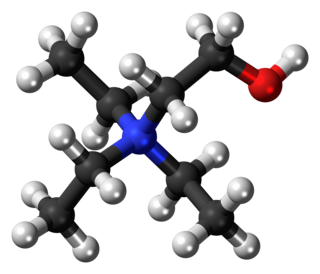
Bretylium (also bretylium tosylate) is an antiarrhythmic agent. It blocks the release of noradrenaline from nerve terminals. In effect, it decreases output from the peripheral sympathetic nervous system. It also acts by blocking K+ channels and is considered a class III antiarrhythmic. The dose is 5–10 mg/kg and side effects are high blood pressure followed by low blood pressure and ventricular ectopy.

Desmetramadol (INN), also known as O-desmethyltramadol (O-DSMT), is an opioid analgesic and the main active metabolite of tramadol. Tramadol is demethylated by the liver enzyme CYP2D6 in the same way as codeine, and so similarly to the variation in effects seen with codeine, individuals who have a less active form of CYP2D6 will tend to get reduced analgesic effects from tramadol. This also results in a ceiling effect which limits tramadol's range of therapeutic benefits to the treatment of moderate pain.

Triethylcholine is a drug which mimics choline, and causes failure of cholinergic transmission by interfering with synthesis of acetylcholine in nerve endings.

8-OH-DPAT is a research chemical of the aminotetralin chemical class which was developed in the 1980s and has been widely used to study the function of the 5-HT1A receptor. It was one of the first major 5-HT1A receptor full agonists to be discovered.

Ciclazindol (WY-23409) is an antidepressant and anorectic drug of the tetracyclic chemical class that was developed in the mid to late 1970s, but was never marketed. It acts as a norepinephrine reuptake inhibitor, and to a lesser extent as a dopamine reuptake inhibitor. Ciclazindol has no effects on the SERT, 5-HT receptors, mACh receptors, or α-adrenergic receptors, and has only weak affinity for the H1 receptor. As suggested by its local anesthetic properties, ciclazindol may also inhibit sodium channels. It is known to block potassium channels as well.

CI-988 (PD-134,308) is a drug which acts as a cholecystokinin antagonist, selective for the CCKB subtype. In animal studies it showed anxiolytic effects and potentiated the analgesic action of both morphine and endogenous opioid peptides, as well as preventing the development of tolerance to opioids and reducing symptoms of withdrawal. Consequently, it was hoped that it might have clinical applications for the treatment of pain and anxiety in humans, but trial results were disappointing with only minimal therapeutic effects observed even at high doses. The reason for the failure of CI-988 and other CCKB antagonists in humans despite their apparent promise in pre-clinical animal studies is unclear, although poor pharmacokinetic properties of the currently available drugs are a possible explanation, and CCKB antagonists are still being researched for possible uses as adjuvants to boost the activity of other drugs.

Stibophen is an anthelmintic classified as antimony compound and used as treatment of schistosomiasis by intramuscular injection.

para-Chloroamphetamine (PCA), also known as 4-chloroamphetamine (4-CA), is a substituted amphetamine and monoamine releaser similar to MDMA, but with substantially higher neurotoxicity, thought to be due to the unrestrained release of both serotonin and dopamine by a metabolite. It is used as a neurotoxin by neurobiologists to selectively kill serotonergic neurons for research purposes, in the same way that 6-hydroxydopamine is used to kill dopaminergic neurons.

Nitroarginine, or Nω-nitro-l-arginine, also known as L-NOARG, is a nitro derivative of the amino acid arginine. It is an inhibitor of nitric oxide synthase and hence a vasoconstrictor. As such, it finds widespread use as a biochemical tool in the study of nitric oxide and its biological effects.

2-Aminotetralin (2-AT), also known as 1,2,3,4-tetrahydronaphthalen-2-amine (THN), is a stimulant drug with a chemical structure consisting of a tetralin group combined with an amine.

Laudexium metilsulfate is a neuromuscular blocking drug or skeletal muscle relaxant in the category of non-depolarizing neuromuscular-blocking drugs, used adjunctively in surgical anesthesia to facilitate endotracheal intubation and to provide skeletal muscle relaxation during surgery or mechanical ventilation.

GR-89696 is a drug which acts as a highly selective κ-opioid agonist. It shows selective effects in different animal models and it is thought it may be a subtype-selective agonist for the κ2 subtype. Recent studies have suggested that GR-89696 and related κ2-selective agonists may be useful for preventing the itching which is a common side effect of conventional opioid analgesic drugs, without the additional side effects of non-selective kappa agonists.

o-Phenyl-3-iodotyramine (o-PIT) is a drug which acts as a selective agonist for the trace amine-associated receptor 1. It has reasonable selectivity for TAAR1 but relatively low potency, and is rapidly metabolised in vivo, making it less useful for research than newer ligands such as RO5166017.

Adibendan is an inhibitor of phosphodiesterase III.

Ro 3-0422 is an extremely potent organophosphate acetylcholinesterase inhibitor. It is extremely toxic. The intravenous LD50 is 20 μg/kg in mice. It is over 300 times more potent than neostigmine.

Ro 3-0419 is a highly toxic organophosphate acetylcholinesterase inhibitor. It's the neutral analog of Ro 3-0422. Although Ro 3-0419 is less potent than Ro 3-0422, it does not have a positively charged nitrogen atom, so it's able to cross the blood brain barrier to inhibit cholinesterases in the brain. The intravenous LD50 of Ro 3-0419 is 1 mg/kg in mice.

TL-1238 is an extremely potent carbamate acetylcholinesterase inhibitor. It has been shown to be more potent than neostigmine.

Choline m-bromophenyl ether (MBF) is an extremely potent nicotinic agonist. It has powerful ganglion stimulating effects. It also causes muscle contractions.
Ro 3-0412 is an acetylcholinesterase inhibitor. It is the organophosphate analog of neostigmine.
BW284C51 is a selective acetylcholinesterase inhibitor. It is also a nicotinic antagonist.


















